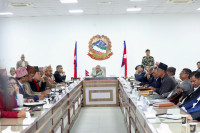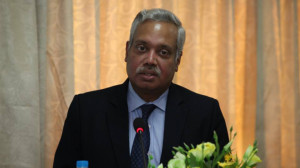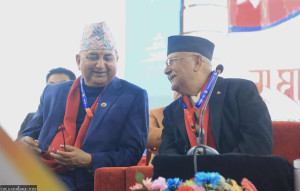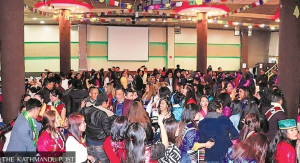National
Disgruntled UML leaders turn to ex-President Bhandari to rein in Oli
As second-rung leaders failed to check his excesses, Bhandari was their best bet.
Purushottam Poudel
Until a few years ago, a group of prominent second-rung CPN-UML leaders used to be projected as future leaders of the party.
Current senior vice-chair Ishwar Pokhrel, Vice-chairmen Bishnu Paudel and Surendra Pandey and General Secretary Shankar Pokhrel were among those touted as future chairpersons.
Of late, these leaders have started to speak up on the shape of future leadership but they are not seeking support for themselves. They have rather thrown their weight behind either repeating current chair KP Sharma Oli or former President Bidya Devi Bhandari, who announced her reentry to the UML amid a function on Saturday.
Four-time prime minister Oli has been chairing the party for the second time since November 2021 while Bhandari returned to her old party after becoming the country’s President for two terms—spread over seven years.
Over the past decade or so, there have been plenty of projections on the UML’s future leadership.
In 2018, when the UML and the Maoist Centre merged to form the Nepal Communist Party, Bishnu Paudel was picked as general secretary of the unified party. Paudel was then widely seen as a potential successor to Oli.
A section of party members projected Shankar Pokhrel as Oli’s successor after he was unanimously elected as a powerful general secretary from the party’s 10th National Congress held in Chitwan in November, 2021.
Apart from Paudel and Pokhrel, Surendra Pandey was also regarded as a potential party leader.
Back in July 2014, Pandey had proved his popularity with the party rank and file when he lost the race for the party general secretary by the slimmest of margins, to Ishwar Pokhrel. Pandey, who served as finance minister from 2009-2011, is counted among only a handful of UML leaders with good command in economic affairs.
However, Pandey’s position within the UML weakened after Madhav Kumar Nepal, along with a group of senior party leaders, split the UML to form CPN (Unified Socialist) in 2021. He had been close to the Nepal faction.
In the party’s general convention in 2014, he fought from the Nepal faction while Pokhrel stood from the Oli panel.
In recent times, both Paudel and Pokhrel have overtaken Pandey in terms of expanding their influence within the party.
There is an ongoing discussion in the UML over the issues of a two-term limit and a 70-year age cap. The party’s 7th general convention held in Janakpur had advocated for the democratisation of the party, while the 8th Congress held in Butwal decided on the two-term limit for leadership positions.
Similarly, the 9th Congress held in Kathmandu in 2014 introduced a provision stipulating that no one can remain in an executive position within the party beyond the age of 70. If this rule is enforced, several current office bearers, including Chairperson Oli, would automatically retire.
But the provisions are yet to be implemented.
Leaders close to Bhandari are lobbying to enforce them in the upcoming Statute Convention to be held in Godavari, Lalitpur from August 5 to 7 while those close to Oli want to do away with the provisions.
The convention will thus be crucial in deciding the fate of the septuagenarian leaders.
But why did the party leaders and cadres feel the need to invite former President Bidya Devi Bhandari instead of promoting second-tier leaders?
In the view of veteran communist leader Radhakrishna Mainali, once it became evident that Oli wouldn’t let second-tier leaders rise, some in the party started searching for someone who matched Oli’s stature—which is where Bhandari entered the picture.
“Right now, no one besides Bhandari can be a viable alternative to Oli,” Mainali told the Post.
When someone who has served as the party’s vice-chair and twice as the country’s President returns to active party politics, it naturally signifies an ambition for the party’s highest position, Mainali claimed.
Bhandari, 64, the former vice-chair of the party and twice President of the country (in 2015 and 2018) had completed her term as head of state in March 2023.
“Even the party’s current vice-chairs were encouraging Bhandari to return to active politics,” a UML leader close to Bhandari told the Post.
The party’s senior vice-chair, Ishwar Pokhrel, has publicly supported Bhandari. While addressing Saturday’s event marking the birth anniversary of Madan Bhandari, Bidya Bhandari’s late husband, Pokhrel not only supported Bhandari’s return to active politics but also criticised the current leadership.
With Bhandari announcing her return to active party politics on Saturday, coinciding with the 74th birth anniversary of Madan Bhandari, some party leaders and cadres are now campaigning to install her as the party’s chair through the 11th general convention.
Although Bhandari has announced her return to active party politics, she has so far minced words about her plan to head the party. However, leaders close to her have openly announced that she is preparing for that.
According to some party leaders, lack of mutual acceptability of second-rung leaders is the main reason behind Bhandari’s re-entry into UML politics.
After Madhav Nepal left the party along with a few of his other critics, Oli established unchecked dominance in the party. Despite some of Oli’s questionable acts, aspiring leaders within the party failed to stop him.
As a result, grassroots leaders no longer place their trust in those who had once been projected as the party’s future leadership.
“Even when Oli was dismantling internal democracy in the party, those who had reached the higher echelons of leadership failed to question or restrain Oli, choosing instead to appease him,” a politburo member said.
“In recent times, the growing criticism directed at the party cannot be attributed solely to opposition forces—mistakes made by our own leadership have also played a role.”
“As the second- and third-tier leaders could not stand up to Oli, there was no alternative to bringing back Bhandari,” another senior UML leader argued.
Political analyst Jhalak Subedi agrees that second-tier leaders may have brought Bhandari forward precisely because they lack the stature to challenge Oli.
“More importantly, under the current party structure, it was not possible for someone to challenge Oli for the party’s leadership,” Subedi said. “Perhaps Bhandari is being propped up as a leader under a transitional arrangement.”
However, party vice-chair Yubaraj Gyawali said the former President has not expressed a desire to hold any position as she has only said that she will be active in party politics.
Gyawali argues that it is premature to debate the issue of the party’s leadership, stating that the Statute Convention in August first week will set a direction for the party’s future leadership, and it is the party’s general convention that will give it a concrete shape.




 7.12°C Kathmandu
7.12°C Kathmandu





.jpg&w=200&height=120)









